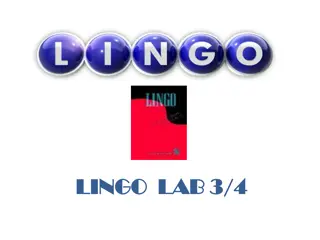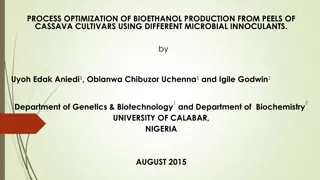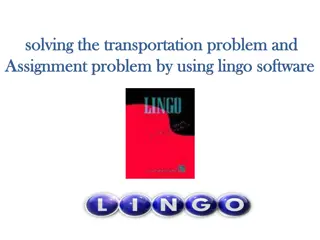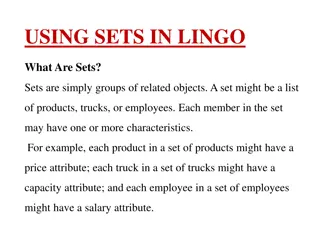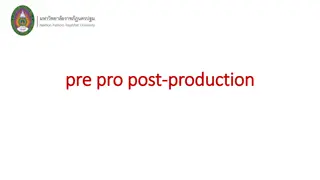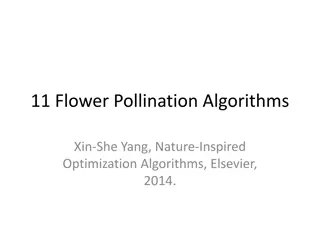Optimization Model for Production Planning Using LINGO
This content describes the optimization model for production planning using LINGO. It covers sets and parameters of the problem, the objective function and constraints, writing the model in LINGO, and solutions for the production models. The models aim to minimize costs while meeting demand and capacity constraints, providing a comprehensive approach to production planning.
Download Presentation

Please find below an Image/Link to download the presentation.
The content on the website is provided AS IS for your information and personal use only. It may not be sold, licensed, or shared on other websites without obtaining consent from the author. Download presentation by click this link. If you encounter any issues during the download, it is possible that the publisher has removed the file from their server.
E N D
Presentation Transcript
LINGO LAB 3 LINGO LAB 3
SOLVING THE MODEL OF A PRODUCTION PLAN BY LINGO
THE PRODUCTION MODEL 1 = + + + min ( ) ( ) z A Y P X H U B V At: fixed setup cost in period t Yt: 0, if there is no production in period t and 1, if there is production in period t Pt: unit variable production cost in period t Xt: amount of production in period t Hk: Inventory holding cost in period k Uk: amount of inventory at the beginning of period k Bk: backlogging cost in period k Vk: amount of backlog at the end of period k Dt: required demand in period t Ct: available capacity in period t t t t t k k k k t T k K t s . . + + = U V X V U 0 D t T 1 1 t t t t t t = X C Y t T t t t = 0 U 0 = 0 V 0 = 0 U 4 = 0 V 4 = } 1 , 0 { 0 X t T t Y t T t = 0 U k K k = 0 V k K k
SETS AND PARAMETERS OF THE PROBLEM Sets and parameters: T={1,2,3,4} K={0,1,2,3,4} A={5000, 7000,8000,4000} D={250,300,400,500} C={500,600,800,900} P={25,30,25,20} H={3,4,5,2} B={5,6,6,7} Decision variables: X={x1, x2, x3, x4}, U={U0,U1,U2,U3,U4}, V={V0,V1,V2,V3,V4}, Y={Y1,Y2,Y3,Y4}
THE OBJECTIVE FUNCTION AND CONSTRAINTS The objective function is to minimize summation of all costs that include fixed setup costs, production costs, inventory holding costs and backlogging costs: The first constraint satisfies demand and is a simple product flow balance equation that can be described by the figure below, and the second constraint avoids capacity violation.
THE PRODUCTION MODEL II = + + + min ( ) ( ) z A Y P X H U B V t t t t k k k k T={1,2 } K={0,1,2} A={6000, 8000} D={500,400} C={600,700} P={40,50} H={7,9,8} B={4,7,5} t T k K t s . . + = 70 U V k K k k = 0 X C Y t T t t t 90 V k k K Decision variables: X={x1, x2,}, U={U0,U1,U2}, V={V0,V1,V2}, Y={Y1,Y2} 0 X D t t t T t T = } 1 , 0 { X t T t Y t T t = 0 U k K k = 0 V k K k
THE PRODUCTION MODEL III We have to prepare an aggregate plan for the future 4 periods. The forecasted demands are D= {250, 300, 330, 270}, Unit production costs are P= {25, 30, 32, 28}$, Fixed setup costs are A= {5000, 4000, 3750, 4500}$. Unit inventory holding costs are H= {5, 5, 5, 5} $ Unit backlogging costs are B= {7, 6, 8, 5} $ Production capacities are C = {500, 500, 600, 600}. The system may increase its production capacity in a period by 200 applying overtime. In overtime production the variable production cost of a product increases by 5$. Moreover, The system may use subcontracting option. Unit subcontracting cost is 40$. Develop the Model of the problem.
THE PRODUCTION MODEL III = + + + + + min ( W . ) ( ) z A Y P X O Z S H U t B V t t t t t t t t t t t t T t T t T + + + + = 0 U V X O S V U = D 1 1 t t t t t t t t X C 200 Y t T t t t = 0 O Y t T t t = 0 X t T t = 0 O t T t = } 1 , 0 { 0 S t T t Y t T t = 0 U k K k = 0 V k K k















